
Wiesbaden is a city in central western Germany and the capital of the state of Hesse. As of June 2020, it had 290,955 inhabitants, plus approximately 21,000 United States citizens. The Wiesbaden urban area is home to approximately 560,000 people. Wiesbaden is the second-largest city in Hesse after Frankfurt am Main.
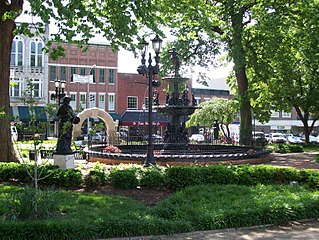
Bowling Green is a home rule-class city and the county seat of Warren County, Kentucky, United States. Founded by pioneers in 1798, Bowling Green was the provisional capital of Confederate Kentucky during the American Civil War. As of the 2020 census, its population of 72,294 made it the third-most-populous city in the state after Louisville and Lexington; its metropolitan area, which is the fourth largest in the state after Louisville, Lexington, and Northern Kentucky, had an estimated population of 179,240; and the combined statistical area it shares with Glasgow has an estimated population of 233,560.

Bowling Green is a small public park in the Financial District of Lower Manhattan, New York City, at the southern end of Broadway. Located next to the site of the original Dutch fort of New Amsterdam, it served as a public place before being designated as a park in 1733. It is the oldest public park in New York City and is surrounded by its original 18th-century fence. It included an actual bowling green and an equestrian statue of King George III prior to the American Revolutionary War.
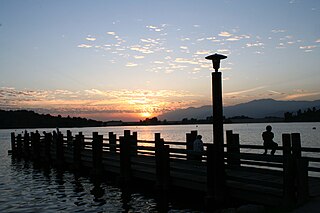
Frank G. Bonelli Regional Park is a man-made recreational area in San Dimas, California, United States, in Los Angeles County. It is near the Orange Freeway, the Foothill Freeway and the San Bernardino Freeway. It is named after former LA County Supervisor Frank G. Bonelli.
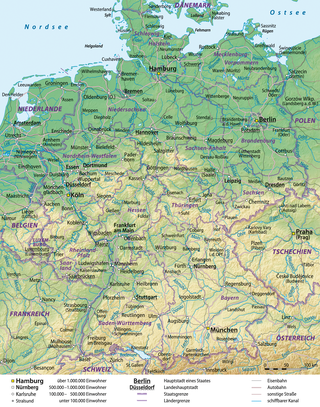
Germany is the eighth-most-visited country in the world, with a total of 407.26 million overnights during 2012. This number includes 68.83 million nights by foreign visitors, the majority of foreign tourists in 2009 coming from the Netherlands, the United Kingdom, and Switzerland. Additionally, more than 30% of Germans spend their holiday in their own country. According to Travel and Tourism Competitiveness Reports, Germany is ranked 3 out of 136 countries in the 2017 report, and is rated as one of the safest travel destinations worldwide.

The Bowling Green station is a station on the IRT Lexington Avenue Line of the New York City Subway, located at Broadway and Battery Place, in the Financial District of Manhattan. It is served by the 4 train at all times and the 5 train at all times except late nights.
The Near East Side is a neighborhood located near downtown Columbus, Ohio, made up of several neighborhoods: Mount Vernon, King-Lincoln Bronzeville, Eastgate, Franklin Park, Nelson Park, Olde Towne East, and Woodland Park.

The Historic Railpark and Train Museum, formerly the Louisville and Nashville Railroad Station in Bowling Green, Kentucky, is located in the historic railroad station. The building was placed on the National Register of Historic Places on December 18, 1979. Opened in 1925, the standing depot is the third Louisville & Nashville Railroad depot that served Bowling Green.

Wiesbaden High School is an American high school located in Wiesbaden, Germany, and is a part of the Department of Defense Dependents Schools, the 9th largest United States School System. Although located in Germany, the school follows a traditional U.S. curriculum and traditional U.S. school activities.

The Kurhaus is a spa resort, casino, and conference complex in Baden-Baden, Germany in the outskirts of the Black Forest.

The Rheingau Musik Festival (RMF) is an international summer music festival in Germany, founded in 1987. It is mostly for classical music, but includes other genres. Concerts take place at culturally important locations, such as Eberbach Abbey and Schloss Johannisberg, in the wine-growing Rheingau region between Wiesbaden and Lorch.

The Wilhemstraße is an urban boulevard in Wiesbaden, state capital of Hesse, Germany. Nicknamed Rue by the locals, the Wilhelmstraße is one of Germany's busiest, upscale shopping streets.
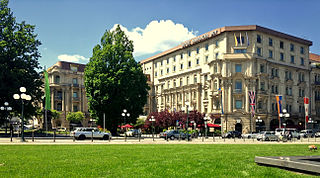
Nassauer Hof is a luxury five-star superior hotel in Wiesbaden, Germany, and member of the international association The Leading Hotels of the World as well as the German association Selektion Deutscher Luxushotels. The property was built in 1813 and is situated across from the Wiesbaden Kurhaus and at the end of Wiesbaden's luxury shopping avenue Wilhelmstrasse.

Wiesbaden City Palace is a neo-classical building in the center of Wiesbaden, Germany. It was completed in 1841 as the principal city residence of the Dukes of Nassau. The palace has several wings, 145 rooms, and is architecturally integrated with a group of ancillary buildings constructed both before and after it was built. With ornate towers, gables and a slate roof laid in herringbone patterns, the three-story complex lends charm and its name to the central square of Wiesbaden: Palace Square.

The Kurhaus is the spa house in Wiesbaden, the capital of Hesse, Germany. It serves as the city's convention centre, and the social center of the spa town. In addition to a large and a smaller hall, it houses a restaurant and the Wiesbaden Casino, or Spielbank, which is notable for allowing the "highest roulette stakes in Germany", and where Fyodor Dostoyevsky was said to have received the inspiration for his novel The Gambler.
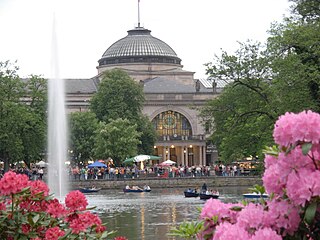
The Kurpark, German for "Spa Park", is a public park in the centre of Wiesbaden, Germany, stretching from the Wilhelmstraße to the southern borders of the district of Sonneberg and lying immediately behind the Kurhaus convention center. It was created in 1852 as an English landscape park and includes a lake where boats can be rented, and a 6 metres (20 ft) tall fountain. It has been described as the most beautiful park in Wiesbaden.

The Warmer Damm is a public park in the centre of Wiesbaden, Germany, stretching from the Wilhelmstraße to the southern borders of the Kurpark and lying immediately in front of the Hessian State Theater. It was created between 1860 and 1861 as an English landscape park and includes a pond.

The Wilhelmstraßenfest is an annual street festival in Wiesbaden, Germany, which began in 1977 in celebration for the reopening of the Hessian state theatre. With roughly 250,000 visitors attending on the two festival days, it is the largest street festival in Germany. It takes place annually during the second weekend of June, on Friday and Saturday, on the namesake Wilhelmstraße and in the adjacent parks of Bowling Green and Warmer Damm. Its official name is "Theatrium." The name "Theatrium" is derived from then from "theater" and "Atrium". The festival offers the largest outdoor event in the city, a variety of culinary specialties, and many music show performances, up to seven large and small stages, rides, a craft market with 130 exhibitors, and a grand finale: a fireworks show.

The Kulturzentrum Schlachthof in Wiesbaden, Hesse, Germany, is a cultural center in a complex which formerly housed the municipal slaughterhouse, approximately 500 meters southeast of the Wiesbaden Hauptbahnhof railway station. The cultural center, known as Schlachthof, was founded in 1994. It offers two concert halls for events from 300 to 2,000 people; the large concert hall has an area of about 1,200 square meters. The location is used for concert in rock, metal and punk, for music parties, poetry slams and readings. It is surrounded by a leisure park.

The Rhön Cycleway is a cycle path in Germany that runs for 180 kilometres from Bad Salzungen to Hammelburg. Its route takes it through 3 states: from Thuringia via Hesse to Bavaria.




















